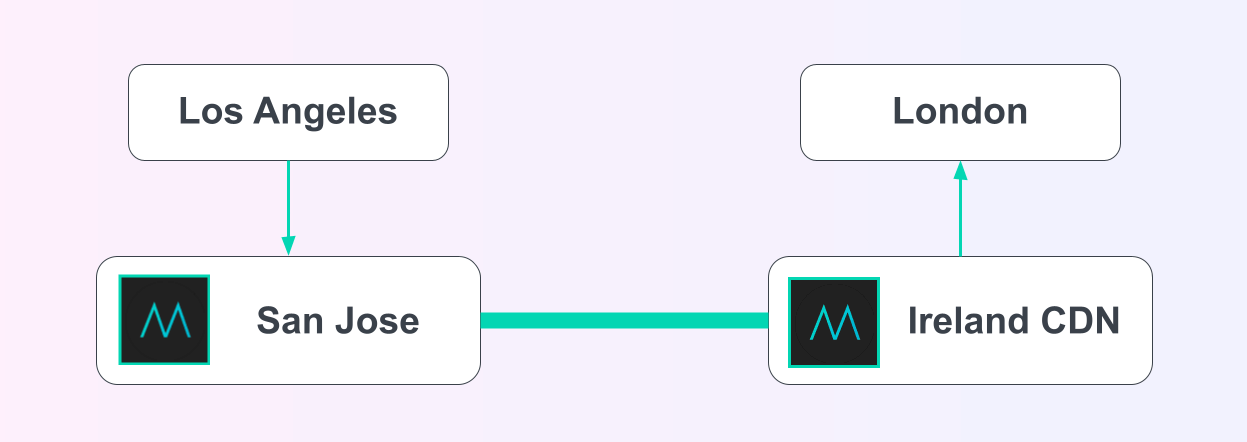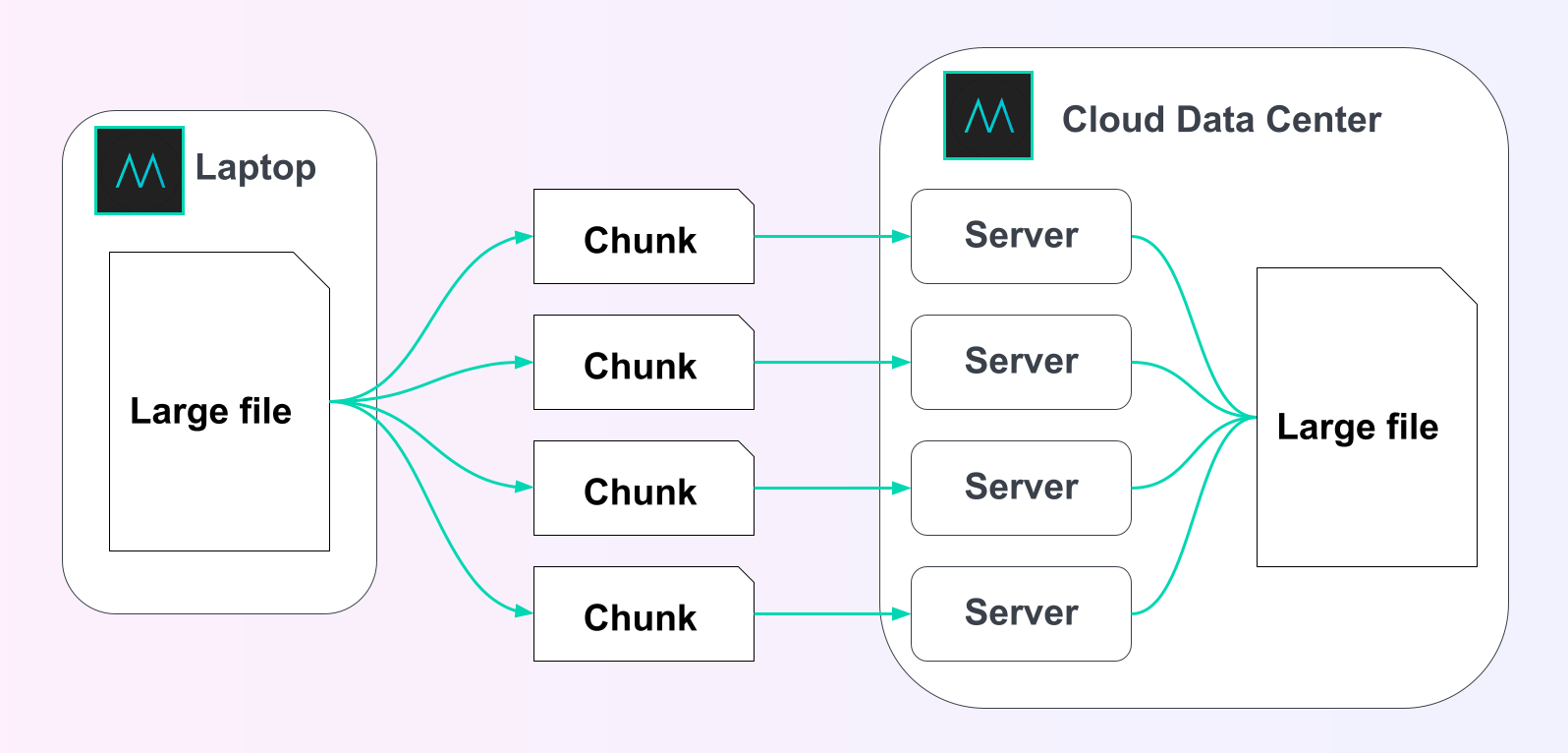This paper explores the file acceleration technologies and techniques used by MASV to boost the delivery speed of terabyte-level files over the internet.
Table of Contents
A Faster Way to Transfer Large Files
Get blazing fast file transfer that’s also easy, secure, and affordable. Sign-up for MASV and get 10 GB free to use each month.
Introduction
In my last paper, I proposed five principles to help determine the best large file transfer solution. One of those principles is speed. As part of my discussion about speed, I touched on MASV’s custom acceleration technology, which dramatically speeds up standard TCP-based file delivery to surpass UDP-based solutions like Aspera and Signiant.
Today, I want to further explore the acceleration technology and elaborate on why MASV is uniquely qualified to deliver files quickly, especially large files, in a stable, secure manner online. As such, I will talk about:
- Why we choose to use TCP instead of UDP.
- Why we send your data on an internet expressway.
- How we add more lanes to the expressway with chunking.
- How we maximize your bandwidth.
- Why we incentivize ourselves to deliver a file so we can get paid.
Just how fast is MASV? Try the File Transfer Time Calculator
Accelerated Large File Transfer for Filmmakers
Why Did We Choose TCP Over UDP?
The debate between UDP and TCP performance ended years ago. Yes, UDP is considered the fastest method for data transfer — but that speed comes at a price. And that price is technical debt in the form of IT support, dropped packets, maintenance, and hours spent on staff training.
MASV chose TCP for good reasons:
1. Fast is good, but you still have to cross the finish line.
To control congestion, networks intentionally drop packets. TCP detects congestion and adjusts to it so it can use network bandwidth as efficiently as possible. By itself, UDP ignores congestion, so it crams more packets onto the network (and potentially loses them).
2. UDP has a reputation as a network bully.
Consequently, some network administrators block UDP traffic. TCP is more likely to work across firewalls without needing to open a ticket with the IT help desk.
3. TCP is easier for you (the end-user).
TCP solves complicated problems out-of-the-box. That lets MASV developers focus on more important things, like solving user’s real problems versus troubleshooting.
UDP-based file transfer services are more complex because they need to reinvent the wheel for reliability and throughput. Some UDP-based vendors even require you to install their own UDP-optimized hardware in your network. TCP-based file transfer leaves these complicated problems to the robust, proven implementations already in the operating system and network infrastructure.
4. Web browsers are agile and secure.
Have you ever seen a browser be down for a significant amount of time? Chances are, no. That’s because the world relies on browsers every day to get their job done. That’s why browser technology — primarily TCP-based — is always up-to-date against errors, bugs, and vulnerabilities. And that’s something UDP-based file transfer providers struggle to protect against in a timely manner.
How Does MASV Accelerate File Transfers?
Now that you know why we chose TCP-based file delivery over UDP, let’s get into MASV’s file acceleration.
1. Our Express Cloud Infrastructure
A common concern many people have with TCP-based file transfer is the distance between servers and the subsequent latency.
That’s where our express cloud infrastructure comes into play. MASV grants traditional TCP-based file delivery access to a smooth, private expressway.
MASV uses Amazon AWS, which has data centers around the world. And AWS has its own, fast, private network for their data centers.
When it sends your file, MASV chooses a data center that’s close to you. Once it’s in the cloud, MASV gets your file to your recipients with a content delivery network (CDN). A CDN is a specialized data center, built to serve data quickly to a geographic region.

Of course, MASV chooses the closest data centers and CDNs for you automatically, all you have to do is send or receive.
If you’re keeping track, MASV leverages the speed, simplicity, and reliability of TCP and supercharges it with access to a private AWS cloud network to accelerate large file transfers.
2. Splitting Large Files During Transit
MASV could send your large file in one request to a single server in the cloud, but that wouldn’t use the network or the cloud efficiently.
In addition to an expressway, MASV further speeds up transfers by splitting your large file into chunks, then sends each chunk to the cloud data center separately. MASV then reassembles your file at the data center.

A cloud data center is built to handle lots of data quickly:
- They have thousands and thousands of servers.
- They offer fast internet connections to the outside world.
- They have even faster networking inside the data center.
As a bonus, chunking shortens the time for recovering from network problems.
The internet is a complicated place where packets can get lost or mangled. If there is a problem with the transfer, MASV only needs to resend a chunk, not the entire file.
To get the file to the data center reliably and securely, MASV does a couple of things:
- To verify that the file it reassembles is the same as the file you sent, MASV uses checksums. Think of a checksum as a fingerprint of the file’s contents.
- Before sending the chunks, MASV encrypts them with Transport Layer Security (TLS), an industry-recognized cryptographic protocol.
💡 Related: How to Protect Against Content Piracy
Fast, Global File Sharing for Remote Teams
Contributors don’t need an account to download files or upload to a MASV Portal.
3. Maximizing Bandwidth Usage
To get the fastest transfer, it’s important to saturate the network. Network saturation means carrying data at the network’s maximum capacity. MASV does this with smart technical decisions and optimizing its implementation:
- Multiple TCP connections are even faster. Before your data arrives at the data center, it might go through network infrastructure that prefers reliability over speed. Another reason MASV uses chunking is to work around this by sending each chunk with its own TCP connection. This way, MASV gets higher throughput while still benefiting from TCP’s reliability.
- High-performance cloud infrastructure. Cloud providers offer different networking tiers that balance cost and performance. When it can take advantage of it, MASV uses the higher-performance services to transfer your large files.
- Optimizing MASV itself. Choosing the right technologies is only the first step. MASV developers spend a lot of time optimizing these technologies to use them as efficiently as possible.
4. Custom Acceleration Features
MASV itself is optimized for fast, reliable transfer in the middle mile, the part of the internet outside your home or office. MASV can also speed up transfers at the last mile, the part of the internet that connects your home or office to the internet.
This is thanks to our custom acceleration features that can be found in the MASV Desktop app.
1. Multiconnect – access to more pipes
The Desktop app can use more than one connection — or network ‘pipes’ — on your laptop or desktop. This is possible with Multiconnect — our channel bonding feature which combines Wi-Fi, ethernet, LTE, 5G, and any other internet connections your computer has.
Multiconnect was designed for remote workers:
- Whether you’re at-home and your single home internet connection isn’t enough;
- Or, you’re at location on a film shoot where Wi-Fi or land-based connections are unreliable (or not available).
2. 10Gbps optimization – access to a bigger pipe
There is a misunderstanding that more internet = faster transfers. While that is true in some regards, whether or not a file transfer service has a big enough pipe to accommodate more internet makes a big difference.
If you’re ready to make the investment to upgrade your networking to 10Gbps, the MASV Desktop app is optimized for the extra bandwidth at no extra charge.
When you turn on 10Gbps file transfer in the app, it does the following:
- Adapts to utilize even more of your bandwidth.
- Uses the counterpart 10Gbps features in the cloud data centers.
3. Time-saving features
The following aren’t ‘acceleration’ technologies with the express purpose of speeding up file transfers. But they are practical features in the Desktop app that help you save time:
Speed Controls
Schedule how much bandwidth to use to align with periods when nobody else is using your home or office network, therefore increasing speed.
Watch Folders
You know what saves a ton of time? Not having to wait for someone to start a transfer. Use Watch Folders to send files automatically.
Priority Transfers
Some files are more urgent than others. Assign priority labels to your transfers so the Desktop app knows which one deserves more bandwidth.
Pause & Resume
Don’t start over if you lose your internet connection or shut down your computer. You can pause transfers then resume them when you’re ready.
5. Bonus: Incentivizing Deliveries
One important thing I haven’t mentioned until now is incentive — a big reason why MASV uses these acceleration technologies for your large files.
Other file transfer solutions keep infrastructure costs down by sharing bandwidth among their users, even to the point of throttling bandwidth. Among its plans, MASV offers pay-as-you-go pricing on downloads. With this plan, we only charge you once a file has been downloaded.
So the faster (and more reliably) you get your large files, the sooner we get paid.
Summary: Why MASV File Acceleration?
To summarize, accelerating large files transfers needs a combination of technologies, properly applied.
At MASV, we use the following to great effect:
- TCP over UDP. It’s proven, fast, reliable, and avoids headaches for your collaborators and IT team.
- We send your data on an internet expressway. This expressway goes through AWS — the largest cloud provider on the planet.
- We add more lanes to the expressway with chunking. That’s an effective use of the cloud’s enormous size and performance. And it speeds up recovery from network problems.
- We maximize your bandwidth. We optimize MASV to fully use your network and take advantage of the higher-performance features in-cloud.
- We save time for you and your collaborators. The MASV Desktop app has even more features to adapt to your schedule and changing situations.
- We don’t throttle. We incentivize ourselves to deliver your large files so we can get paid.
Transferring large files fast and reliably saves you time and increases your productivity. With MASV’s acceleration technology, you can move large files quickly so you can focus on your work and meet your deadlines.
I invite you to try MASV’s acceleration technology out for yourself. Sign-up with this link and you’ll get 10 GB free to use each month to try things out.
Fast, Easy, and Secure Transfer of Large Files
Get 10 GB of data free to use right away.